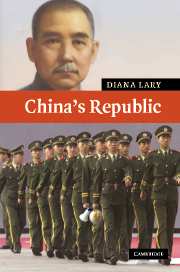Book contents
- Frontmatter
- Contents
- List of illustrations
- List of maps
- List of tables
- Acknowledgments
- Introduction
- 1 The decline of empire, the dream of a republic: 1890s–1911
- 2 The early Republic – chaos and creativity: 1912–28
- 3 The Nanjing decade – a new beginning? 1928–37
- 4 The Resistance War – warfare and chaos: 1937–45
- 5 The Civil War – the most vicious conflict: 1946–9
- 6 More than survival – the Republic on Taiwan: 1949 to the present
- Conclusion: the end of the Republic?
- Index of names
- Index of places
- Index of subjects
- References
4 - The Resistance War – warfare and chaos: 1937–45
Published online by Cambridge University Press: 05 June 2012
- Frontmatter
- Contents
- List of illustrations
- List of maps
- List of tables
- Acknowledgments
- Introduction
- 1 The decline of empire, the dream of a republic: 1890s–1911
- 2 The early Republic – chaos and creativity: 1912–28
- 3 The Nanjing decade – a new beginning? 1928–37
- 4 The Resistance War – warfare and chaos: 1937–45
- 5 The Civil War – the most vicious conflict: 1946–9
- 6 More than survival – the Republic on Taiwan: 1949 to the present
- Conclusion: the end of the Republic?
- Index of names
- Index of places
- Index of subjects
- References
Summary
The Resistance War against the Japanese invasion of the heartland of China started on a high tide of patriotism, a passionate spirit of resistance that made legions of Chinese willing to sacrifice their lives for the nation. But this spirit dissipated as the war dragged on. Eight years of war and occupation brought devastation to much of China. Almost all of China's major cities, industrial regions, ports, and transport arteries were occupied by Japanese armies. Half of China's people lived in the occupied areas. The casualties were devastating. More than 3 million Chinese soldiers were killed, or died of injury or illness during the war, and as many as 18 million civilians lost their lives. Tens of millions of people fled to the interior from the occupied areas. The modern trading and industrial economy was almost destroyed. Much of China's society was disrupted or torn apart. The modern, civilian China, the civil society that had evolved so painfully in the late Qing and the first decades of the Republic, was lost. China was divided into many parts. There could be no attention to the problem of poverty, as much of China's prewar economy collapsed.
The warfare that started in 1937 lasted until 1945, and then continued under another name until 1949. By the end of the Resistance War China was exhausted, and more divided than ever. There were bitter recriminations, which continue until today, over who was to blame for the way the war had gone.
- Type
- Chapter
- Information
- China's Republic , pp. 112 - 150Publisher: Cambridge University PressPrint publication year: 2007

